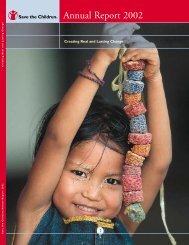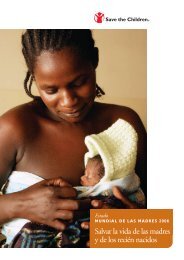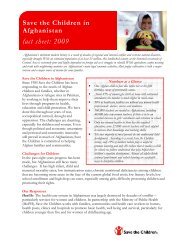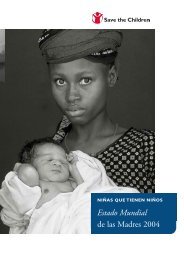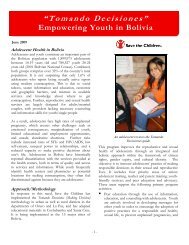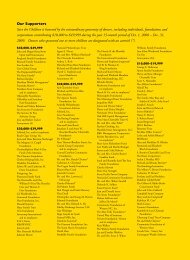Adolescent Sexual and Reproductive Health Toolkit for - UNFPA
Adolescent Sexual and Reproductive Health Toolkit for - UNFPA
Adolescent Sexual and Reproductive Health Toolkit for - UNFPA
You also want an ePaper? Increase the reach of your titles
YUMPU automatically turns print PDFs into web optimized ePapers that Google loves.
About the ASRH <strong>Toolkit</strong> <strong>for</strong> Humanitarian Settings<br />
The ASRH <strong>Toolkit</strong> <strong>for</strong> Humanitarian Settings provides in<strong>for</strong>mation <strong>and</strong> guidance to advocate <strong>for</strong> ASRH<br />
<strong>and</strong> implement adolescent-inclusive SRH interventions. The toolkit is meant to accompany Chapter 4<br />
“<strong>Adolescent</strong> <strong>Reproductive</strong> <strong>Health</strong>” of the Inter-Agency Field Manual on <strong>Reproductive</strong> <strong>Health</strong> in humanitarian<br />
settings, IAFM. The tools have been conceived to operationalize this chapter by providing guidance on<br />
what should be done to ensure that sexual <strong>and</strong> reproductive health interventions put into place during<br />
<strong>and</strong> immediately after a crisis are responsive to the needs of adolescents.<br />
While the best way to ensure that ASRH needs are met is to mainstream ASRH into the emergency<br />
RH response, mainstreaming is a process that requires planning <strong>and</strong> co-ordination <strong>and</strong> often implementing<br />
agencies do not have the time, resources or capacity to do this during an acute emergency.<br />
Recognizing that mainstreaming approaches to mainstreaming ASRH in emergencies have not yet been<br />
st<strong>and</strong>ardized, this ASRH <strong>Toolkit</strong> has been designed to help program managers at implementing agencies<br />
ensure that the sexual <strong>and</strong> reproductive health needs of adolescents are addressed during all emergency<br />
situations, be they natural or man-made. It also provides selected tools specifically <strong>for</strong> health providers so<br />
they can more effectively provide <strong>and</strong> track services <strong>for</strong> adolescents at the clinic <strong>and</strong> community levels.<br />
The tools are designed to be user-friendly so that service providers who have never been trained to work<br />
with adolescents can feel com<strong>for</strong>table treating them during an emergency.<br />
Each humanitarian situation is unique, <strong>and</strong> it is expected that the tools will be adapted to suit the particular<br />
needs on the ground. It is also expected that the <strong>Toolkit</strong> will be used to raise awareness about the SRH<br />
needs of adolescents <strong>and</strong> as an initial step of mainstreaming ASRH into emergency RH responses.<br />
community is crucial to minimizing their SRH risk.<br />
Preventing adolescents from becoming separated<br />
from their families is a priority during an emergency<br />
situation, <strong>and</strong> creating safe spaces <strong>and</strong><br />
beginning education activities during a crisis can<br />
minimize idle time among adolescents <strong>and</strong> aid in<br />
preventing them from being abducted or otherwise<br />
targeted in an armed conflict. Awareness<br />
raising <strong>and</strong> sensitization sessions on HIV <strong>for</strong><br />
receiving communities should begin well be<strong>for</strong>e<br />
reintegration of adolescents commences to<br />
counter any stigma or discrimination from the<br />
communities. Strong protection measures <strong>and</strong><br />
strengthening community-based approaches to<br />
livelihoods <strong>and</strong> education can also contribute to<br />
the prevention of re-recruitment or harmful<br />
behaviors such as selling sex.<br />
<strong>Sexual</strong> <strong>and</strong> <strong>Reproductive</strong> <strong>Health</strong> Needs of<br />
<strong>Adolescent</strong> Boys: <strong>Adolescent</strong> girls are most at<br />
risk during emergency situations, but addressing<br />
the needs of adolescent boys is equally urgent;<br />
ASRH programs should recognize the specific<br />
SRH needs of adolescent boys. <strong>Adolescent</strong> boys<br />
have an important role to play in improving the<br />
health situation <strong>for</strong> adolescent girls. Including<br />
both boys <strong>and</strong> girls in discussions on power <strong>and</strong><br />
gender equality can reduce the risk of GBV <strong>and</strong><br />
can lead to changes in the existing gender norms<br />
that contribute to GBV <strong>and</strong> exclusion of girls<br />
from health services. <strong>Adolescent</strong> boys face high<br />
rates of STI <strong>and</strong> HIV/AIDS (although not as high<br />
as females.) By providing boys with in<strong>for</strong>mation<br />
about sexual health <strong>and</strong> ensuring that they have<br />
access to high-quality, adolescent-friendly<br />
SRH services, high-risk sexual behavior among<br />
adolescent boys may be mitigated. Boys also<br />
are targeted <strong>for</strong> recruitment to armed <strong>for</strong>ces<br />
<strong>and</strong> armed groups, where they are at risk of<br />
being subject to <strong>and</strong> committing exploitation <strong>and</strong><br />
abuse, in addition to being induced or pressured<br />
toward risk-taking behaviors.<br />
10<br />
<strong>Adolescent</strong> <strong>Sexual</strong> <strong>and</strong> <strong>Reproductive</strong> <strong>Health</strong> <strong>Toolkit</strong> <strong>for</strong> Humanitarian Settings




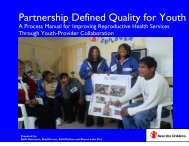

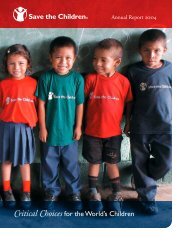
![View full document [PDF 3.39 MB] - PreventionWeb](https://img.yumpu.com/27308954/1/190x245/view-full-document-pdf-339-mb-preventionweb.jpg?quality=85)
